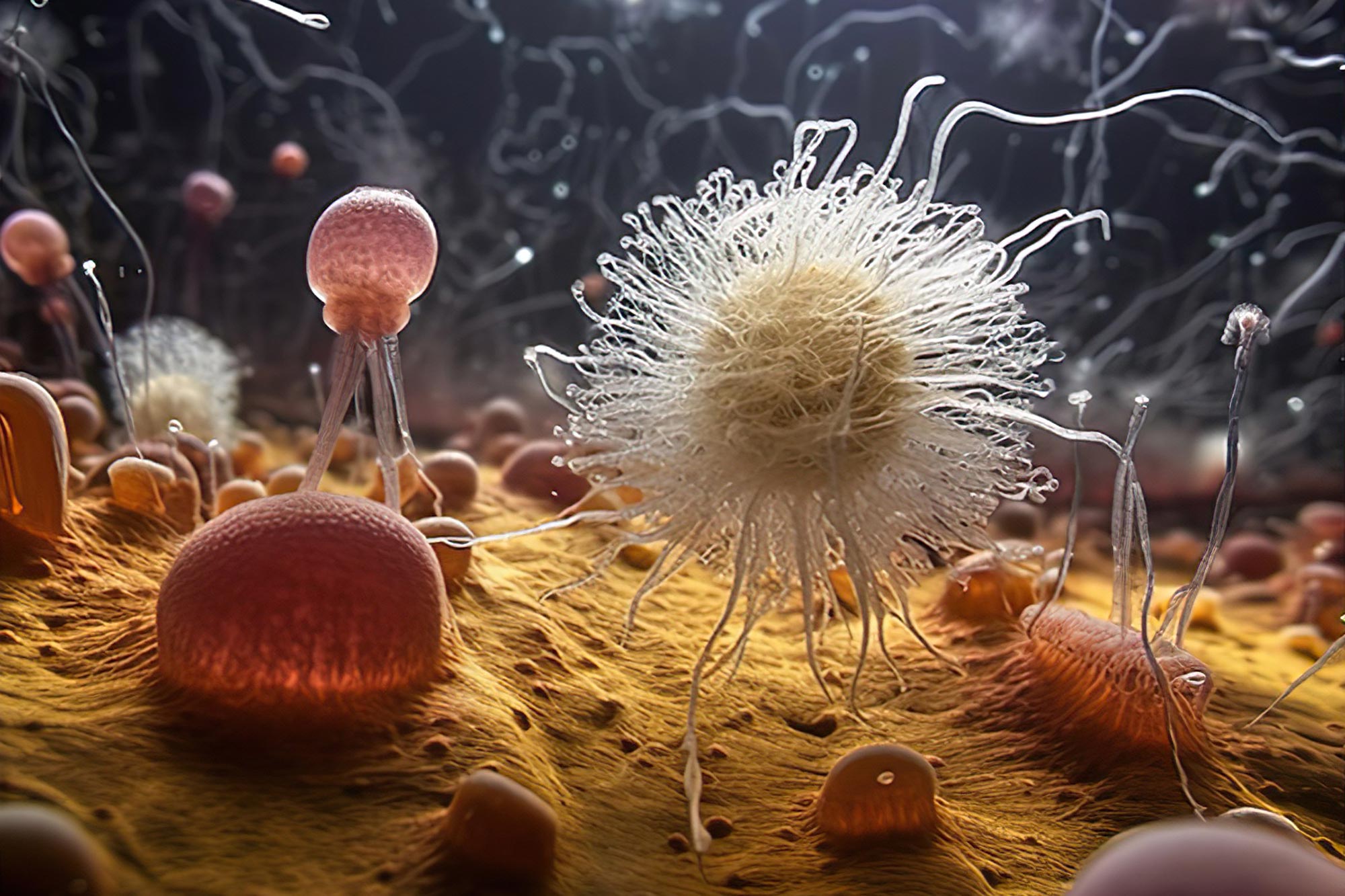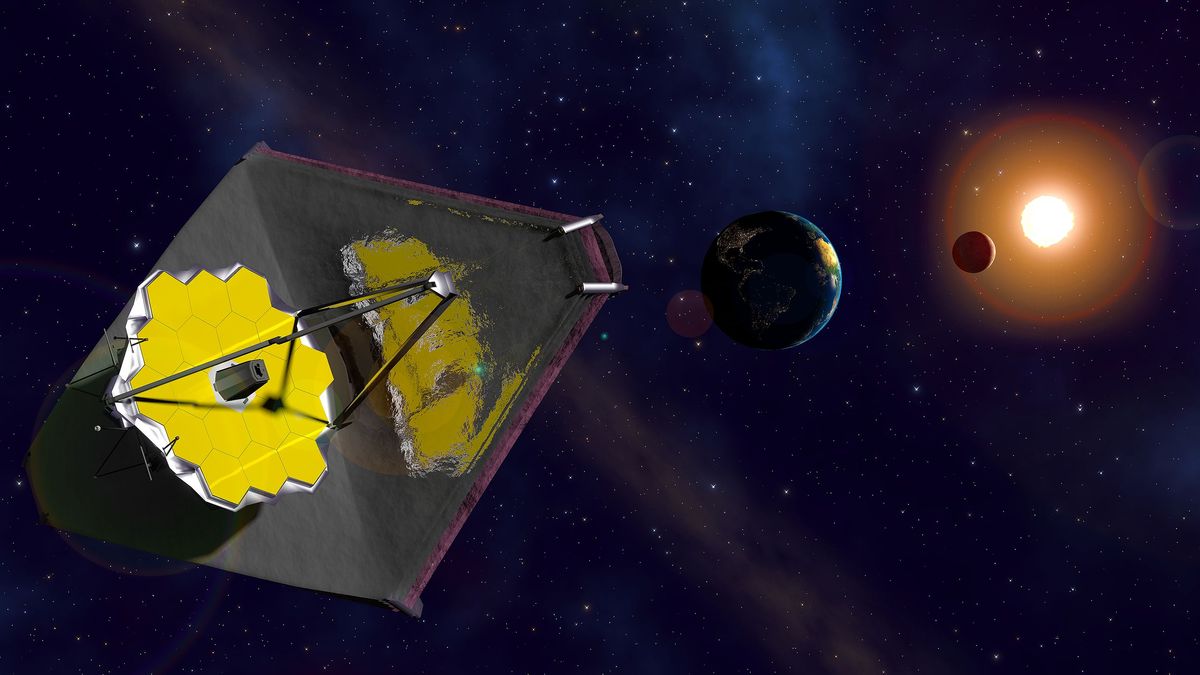Vedci objavujú „stratený svet“ našich skorých predkov v miliardách rokov starých skalách

Autor:
Umelcova vizualizácia zoskupenia skorých eukaryotických organizmov „protosterolovej bioty“ žijúcich v bakteriálnej podložke na dne oceánu. Na základe molekulárnych fosílií žili organizmy protosterolovej bioty v oceánoch približne pred 1,6 až 1,0 miliardou rokov a sú našimi najstaršími predkami. Kredit: Orchestrated at Midjourney by TA2023
Nadnárodný výskumný tím našiel staroveké protosteroidy v horninách, čo naznačuje, že zložitý život existoval už pred 1,6 miliardami rokov. Tieto molekuly poskytujú nový pohľad na vývoj komplexného života a riešia nezrovnalosti medzi konvenčnými a lipidovými fosílnymi záznamami.
Ukázalo sa, že novoobjavené záznamy o takzvaných protosteroidoch boli v stredoveku Zeme prekvapivo hojné. Najskoršie molekuly boli produkované v skoršom štádiu eukaryotickej zložitosti – súčasný záznam fosílnych steroidov siahal pred viac ako 800 až 1600 miliónmi rokov. Eukaryoty je termín pre kráľovstvo života, ktoré zahŕňa všetky živočíchy, rastliny a riasy a líši sa od baktérií komplexnou bunkovou štruktúrou, ktorá zahŕňa jadro, ako aj zložitejší molekulárny mechanizmus.
„Hlavným momentom tohto objavu nie je rozšírenie súčasného molekulárneho záznamu eukaryotov,“ hovorí Christian Hollmann, jeden zo zúčastnených vedcov z Nemeckého výskumného centra pre geovedy (GFZ) v Postupime. „Vzhľadom na to, že posledný spoločný predok všetkých moderných eukaryotov, vrátane nás ľudí, bol schopný produkovať ‚bežné‘ moderné steroly, je vysoká pravdepodobnosť, že eukaryoty zodpovedné za tieto vzácne podpisy patrili do kmeňa fylogenetického stromu.“

Benjamin Nettersheim, jeden z hlavných autorov štúdie, skúma elementárne a molekulárne mapy s ultravysokým rozlíšením 1,64 miliardy rokov starých vzoriek hornín analyzovaných v Geobomolecular Imaging Laboratory v Marum. Poďakovanie: MARUM – Centrum pre morské životné prostredie, Univerzita v Brémach; v. diekamp
Tento „stonok“ predstavuje spoločnú rodovú líniu, ktorá bola predchodcom všetkých ešte žijúcich vetiev eukaryotov. Jeho zástupcovia už dávno vyhynuli, no opis ich povahy môže vrhnúť viac svetla na podmienky vývoja zložitého života. Hoci je potrebný ďalší výskum na vyhodnotenie toho, aké percento protosteroidov môže mať vzácny bakteriálny zdroj, objav týchto nových molekúl nielen zosúlaďuje geologický záznam tradičných fosílií s molekulami fosílnych lipidov, ale poskytuje aj vzácny a bezprecedentný pohľad. Stratený svet starovekého života. Konkurenčný zánik eukaryotov, kmeňovej skupiny poznačenej prvým objavením sa moderných fosílnych steroidov asi pred 800 miliónmi rokov, môže odrážať jednu z najdôležitejších udalostí vo vývoji čoraz zložitejšieho života.
„Takmer všetky eukaryoty biosyntetizujú steroidy, ako je cholesterol, ktorý produkujú ľudia a väčšina ostatných zvierat,“ hovorí Benjamin Nettersheim z University of Marum v Brémach, ktorý zdieľa prvé autorstvo štúdie s Jochenom Brocksom.[{“ attribute=““>Australian National University (ANU) – “due to potentially adverse health effects of elevated cholesterol levels in humans, cholesterol doesn’t have the best reputation from a medical perspective. However, these lipid molecules are integral parts of eukaryotic cell membranes where they aid in a variety of physiological functions. By searching for fossilized steroids in ancient rocks, we can trace the evolution of increasingly complex life.”

Dr. Nettersheim inserts a thin section and rock slices of 1.64 billion-years old rocks into the 7T solariX XR FT-ICR-MS equipped with a MALDI source at the Geobiomolecular Imaging Laboratory at MARUM. As part of ongoing research into mid-Proterozoic biomarker signatures at MARUM, GFZ and the Australian National University, Dr. Nettersheim aims to zoom into the cradle of eukaryotic life in unprecedented resolution. Credit: MARUM – Center for Marine Environmental Sciences, University of Bremen; V. Diekamp
Nobel laureate Konrad Bloch had already speculated about such a biomarker in an essay almost 30 years ago. Bloch suggested that short-lived intermediates in the modern biosynthesis of steroids may not always have been intermediates. He believed that lipid biosynthesis evolved in parallel with changing environmental conditions throughout Earth history. In contrast to Bloch, who did not believe that these ancient intermediates could ever be found, Nettersheim started searching for protosteroids in ancient rocks that were deposited at a time when those intermediates could actually have been the final product.
But how to find such molecules in ancient rocks? “We employed a combination of techniques to first convert various modern steroids to their fossilized equivalent; otherwise, we wouldn’t have even known what to look for,” says Jochen Brocks. Scientists had overlooked these molecules for decades because they do not conform to typical molecular search images. “Once we knew our target, we discovered that dozens of other rocks, taken from billion-year-old waterways across the world, were oozing with similar fossil molecules.”
The oldest samples with the biomarker are from the Barney Creek Formation in Australia and are 1.64 billion years old. The rock record of the next 800 million years only yields fossil molecules of primordial eukaryotes before molecular signatures of modern eukaryotes first appear in the Tonian period. According to Nettersheim “the Tonian Transformation emerges as one of the most profound ecological turning points in our planet´s history“. Hallmann adds that “both primordial stem groups and modern eukaryotic representatives such as red algae may have lived side by side for many hundreds of millions of years”. During this time, however, the Earth’s atmosphere became increasingly enriched with oxygen – a metabolic product of cyanobacteria and of the first eukaryotic algae – that would have been toxic to many other organisms. Later, global “Snowball Earth” glaciations occurred and the protosterol communities largely died out. The last common ancestor of all living eukaryotes may have lived 1.2 to 1.8 billion years ago. Its descendants were likely better able to survive heat and cold as well as UV radiation and displaced their primordial relatives.
“Earth was a microbial world for much of its history and left few traces,” Nettersheim concludes. Research at ANU, MARUM and GFZ continues to pursue tracing the roots of our existence – the discovery of protosterols now brings us one step closer to understanding how our earliest ancestors lived and evolved. Shooting at the ancient rocks with a laser coupled to an ultra-high resolution mass spectrometer in MARUM’s globally unique Geobiomolecular Imaging Laboratory, Dr. Nettersheim and his international collaborators aim at zooming into the cradle of eukaryotic life in unprecedented resolution to further improve our understanding of our early ancestors in the future.
Reference: “Lost world of complex life and the late rise of the eukaryotic crown” by Jochen J. Brocks, Benjamin J. Nettersheim, Pierre Adam, Philippe Schaeffer, Amber J. M. Jarrett, Nur Güneli, Tharika Liyanage, Lennart M. van Maldegem, Christian Hallmann and Janet M. Hope, 7 June 2023, Nature.
DOI: 10.1038/s41586-023-06170-w
Participating Institutions:
- Research School of Earth Sciences, The Australian National University, Canberra, Australia
- MARUM – Center for Marine Environmental Sciences, University of Bremen, Bremen, Germany
- Faculty of Geosciences, University of Bremen, Bremen, Germany
- Université de Strasbourg, CNRS, Institut de Chimie de Strasbourg, Strasbourg, France
- Northern Territory Geological Survey, Darwin, Australia
- German Research Center for Geosciences (GFZ), Potsdam, Germany
MARUM produces fundamental scientific knowledge about the role of the ocean and the ocean floor in the total Earth system. The dynamics of the ocean and the ocean floor significantly impact the entire Earth system through the interaction of geological, physical, biological and chemical processes. These influence both the climate and the global carbon cycle, and create unique biological systems. MARUM is committed to fundamental and unbiased research in the interests of society and the marine environment, and in accordance with the Sustainable Development Goals of the United Nations. It publishes its quality-assured scientific data and makes it publicly available. MARUM informs the public about new discoveries in the marine environment and provides practical knowledge through its dialogue with society. MARUM cooperates with commercial and industrial partners in accordance with its goal of protecting the marine environment.

Web nerd. Organizátor extrémov. Spisovateľ. Evanjelista celkom potravín. Certifikovaný introvert.





